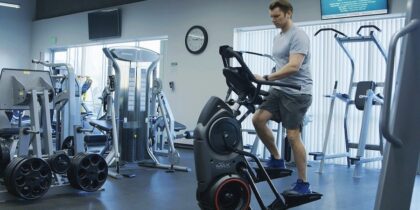Everyone wants to be healthy and fit, but gym-goers often find themselves fighting the battle of motivation to get there. As workout franchises — not to mention company wellness programs at major corporate campuses — hunt for ways to improve the gym experience, virtual reality is becoming one of the hottest trends in the battle to keep fitness fun.
Immersion Makes the Difference
One of the most attractive draws of the virtual reality experience is the immersive feeling it creates. Inside these environments, users get the sense of being somewhere else.
Consumer-facing fitness VR applications simply move past enjoying the view and provide a compelling distraction. Users are challenged to move and compete against themselves and others. The gaming action paired with the immersive experience makes time seem to fly. This combats the boredom many people associate with exercise, and adds a positive feeling of achieving fitness goals through tracked progress.
More Like Play Than Work
Companies such as VirZOOM are already taking advantage of increased interest, combining VR tech, like the Samsung Gear VR headset, with stationary bikes. VirZOOM creates and sells their own bikes equipped with gameplay buttons and triggers that consumers can pair with VR headsets. In addition to pedaling speed and heart rate, VirZOOM also offers quarter-sized sensors that can track speed and translates into the motion inside their game apps.
The company offers eight immersive games that range from cycling competitions to car races to rides on a flying horse. They have expanded to multiplayer games where users compete in real-time with others or challenge them to beat their score. Users can also create a custom playlist of favorite games, as well as track and share progress.
VirZOOM is Changing the Fitness Club Experience
Get insight on how VirZOOM is developing their applications to make workouts more engaging. Download Now
The social and competitive features make the gym-going experience more entertaining and motivating. By being able to track and share progress within a social setting, users can see a tangible benefit to their workouts and try different immersion experiences. Gyms can take advantage of this increased interest and use VR as a way to keep members coming back.
Initially appealing to the consumer market, VirZOOM’s next move has been to partner with fitness clubs and other fitness-focused businesses by creating gym-ready bikes that fully integrate with VirZOOM games using a VR headset.
Attracting More Than Gym Enthusiasts
Exercise facilities and franchises are watching VR fitness-based businesses with optimism. They hope consumer excitement and gym adoption will be fueled by what’s happening in the industry:
-
The pull of partnerships. Several of these new entrants into the VR field are partnering with more established fitness apps to gain credibility. For example, VirZOOM has partnered with a popular fitness tracker and credit for a VR bike ride loads directly into the user’s app. This makes the overall user experience much smoother and creates an easier adoption process.
-
Increased awareness. Not every consumer can afford to buy a VR-based fitness setup for their home. By having equipment at the gym, users can try out the technology without having to invest in a personal setup.
-
More social interaction. Fitness applications are becoming more social and competitive using tools like leaderboards and video chats to connect with other users during real-time VR events.
-
Improved content. Earlier generations of VR games and applications were simplistic and the environments were clearly computer generated. Content creators are working on making the environments more realistic so they will be closer to a more realistic experience.
The more steps that VR fitness-based business make like this, the more the technology will appeal to gym members. As the experience improves, gym owners will more quickly reap the benefits of incorporating VR into their customer offerings.
Considerations for Implementation
As a business decision, gym and fitness franchises must consider how to best incorporate VR technology into their operations. Cost is one consideration. Is the equipment reasonable enough that the gym can recoup its investment pretty easily? The lifetime of the equipment and future replacement costs have to be considered as well since most purchases are not a one-time investment.
Additionally, how easy is the equipment to set up, use and maintain? These tasks will likely fall to gym employees, who may be well-versed in traditional machines, but not as comfortable using tech. Ideally, getting VR systems up and running, and keeping them that way, should be as easy to execute as possible.
The emergence of VR for fitness presents a plethora of opportunities for both technology companies and workout franchises alike. Gyms can use it as a way to attract and retain customers, and VR organizations can find a new application space. Meanwhile, for gyms on corporate campuses or in partnerships with large-scale wellness programs, the introduction of VR creates opportunities to engage workers in those programs and get them to be more enthusiastic about participating. With this changing status quo, fitness may finally be just a little more fun.
Learn how virtual reality can help create a more engaging fitness experience.








